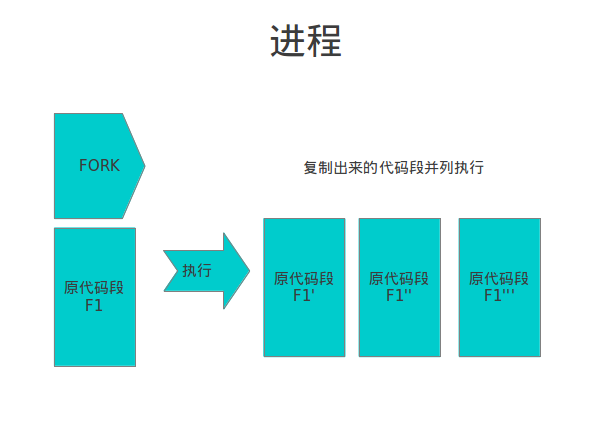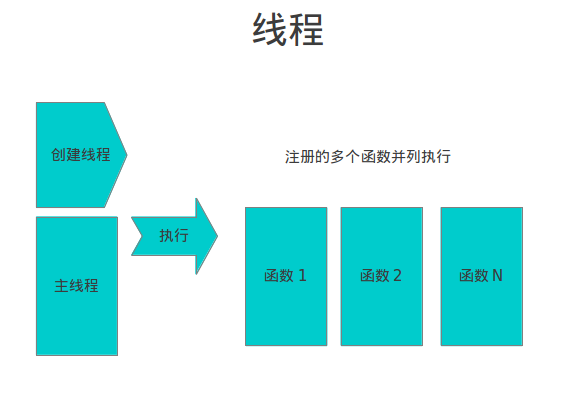原文地址:http://blog.csdn.net/liang890319/article/details/8393120
进程简单的说就是把一段代码复制成多份,并让他们同时执行。进程间通信是为了让他们有序的运行

线程简单的说就是让多个函数同时执行,线程间通信是为了让他们有序的运行

编译线程程序时会警告说线程函数找不到
pthread 库不是 Linux 系统默认的库,连接时需要使用静态库 libpthread.a,所以在使用pthread_create()创建线程,以及调用 pthread_atfork()函数建立fork处理程序时,需要链接该库。
问题解决:
在编译中要加 -lpthread参数
gcc thread.c -o thread -lpthread
thread.c为你些的源文件,不要忘了加上头文件#include<pthread.h>
http://blog.csdn.net/llqkk/article/details/2854558
实例1:创建两个线程,同时执行同一个函数
/* ex7-1.c */
#include <stddef.h>
#include <stdio.h>
#include <unistd.h>
#include <pthread.h>
#include <string.h>
void print_msg(char *ptr);
int main()
{
pthread_t thread1, thread2;
int i,j;
char *msg1="do sth1
";
char *msg2="do sth2
";
pthread_create(&thread1,NULL, (void *)(&print_msg), (void *)msg1);
pthread_create(&thread2,NULL, (void *)(&print_msg), (void *)msg2);
sleep(1);
return 0;
}
void print_msg(char *ptr)
{
int retval;
int id=pthread_self();
printf("Thread ID: %x
",id);
printf("%s",ptr);
pthread_exit(&retval);
}
执行gcc ex7-1.c -lpthread
./a.out
实例2 创建多个线程执行不同函数
代码来自 http://www.cnblogs.com/BiffoLee/archive/2011/11/18/2254540.html
#include <pthread.h>
#include <stdio.h>
#include <sys/time.h>
#include <string.h>
#define MAX 10
pthread_t thread[2];
pthread_mutex_t mut;
int number=0, i;
void *thread1()
{
printf ("thread1 : I'm thread 1
");
for (i = 0; i < MAX; i++)
{
printf("thread1 : number = %d
",number);
pthread_mutex_lock(&mut);
number++;
pthread_mutex_unlock(&mut);
sleep(2);
}
printf("thread1 :主函数在等我完成任务吗?
");
pthread_exit(NULL);
}
void *thread2()
{
printf("thread2 : I'm thread 2
");
for (i = 0; i < MAX; i++)
{
printf("thread2 : number = %d
",number);
pthread_mutex_lock(&mut);
number++;
pthread_mutex_unlock(&mut);
sleep(3);
}
printf("thread2 :主函数在等我完成任务吗?
");
pthread_exit(NULL);
}
void thread_create(void)
{
int temp;
memset(&thread, 0, sizeof(thread)); //comment1
//创建线程
if((temp = pthread_create(&thread[0], NULL, thread1, NULL)) != 0) //comment2
printf("线程1创建失败!
");
else
printf("线程1被创建
");
if((temp = pthread_create(&thread[1], NULL, thread2, NULL)) != 0) //comment3
printf("线程2创建失败");
else
printf("线程2被创建
");
}
void thread_wait(void)
{
//等待线程结束
if(thread[0] !=0) { //comment4
pthread_join(thread[0],NULL);
printf("线程1已经结束
");
}
if(thread[1] !=0) { //comment5
pthread_join(thread[1],NULL);
printf("线程2已经结束
");
}
}
int main()
{
//用默认属性初始化互斥锁
pthread_mutex_init(&mut,NULL);
printf("我是主函数哦,我正在创建线程,呵呵
");
thread_create();
printf("我是主函数哦,我正在等待线程完成任务阿,呵呵
");
thread_wait();
return 0;
}
编译 :
gcc -lpthread -o thread_example lp.c
实例3:信号量控制线程运行顺序
/* thread_sem.c */
#include <stdio.h>
#include <stdlib.h>
#include <pthread.h>
#include <semaphore.h>
#define THREAD_NUMBER 3
#define REPEAT_NUMBER 3
#define DELAY_TIME_LEVELS 10.0
sem_t sem[THREAD_NUMBER];
void * thrd_func(void *arg)
{
int thrd_num = (int)arg;
int delay_time = 0;
int count = 0;
sem_wait(&sem[thrd_num]);
printf("Thread %d is starting
", thrd_num);
for (count = 0; count < REPEAT_NUMBER; count++)
{
delay_time = (int)(rand() * DELAY_TIME_LEVELS/(RAND_MAX)) + 1;
sleep(delay_time);
printf(" Thread %d: job %d delay = %d
", thrd_num, count, delay_time);
}
printf("Thread %d finished
", thrd_num);
pthread_exit(NULL);
}
int main(void)
{
pthread_t thread[THREAD_NUMBER];
int no = 0, res;
void * thrd_ret;
srand(time(NULL));
for (no = 0; no < THREAD_NUMBER; no++)
{
sem_init(&sem[no], 0, 0);
res = pthread_create(&thread[no], NULL, thrd_func, (void*)no);
if (res != 0)
{
printf("Create thread %d failed
", no);
exit(res);
}
}
printf("Create treads success
Waiting for threads to finish...
");
sem_post(&sem[THREAD_NUMBER - 1]);
for (no = THREAD_NUMBER - 1; no >= 0; no--)
{
res = pthread_join(thread[no], &thrd_ret);
if (!res)
{
printf("Thread %d joined
", no);
}
else
{
printf("Thread %d join failed
", no);
}
sem_post(&sem[(no + THREAD_NUMBER - 1) % THREAD_NUMBER]);
}
for (no = 0; no < THREAD_NUMBER; no++)
{
sem_destroy(&sem[no]);
}
return 0;
}
实例4:互斥锁的使用
在这个程序中,一个线程要往缓冲区写数据,另一个线程要读数据,每次只能让一个线程操作缓冲区
/*ex7-3.c*/
#include <stddef.h>
#include <stdio.h>
#include <unistd.h>
#include <pthread.h>
#define FALSE 0
#define TRUE 1
void readfun();
void writefun();
char buffer[256];
int buffer_has_item=0;
int retflag=FALSE,i=0;
pthread_mutex_t mutex;
int main()
{
void *retval;
pthread_t reader;
pthread_mutex_init(&mutex,NULL);
pthread_create(&reader,NULL,(void *)&readfun,NULL);
writefun();
pthread_join(reader,&retval);
}
void readfun()
{
while(1)
{
if(retflag)
return;
pthread_mutex_lock(&mutex);
if(buffer_has_item==1)
{
printf("%s",buffer);
buffer_has_item=0;
}
pthread_mutex_unlock(&mutex);
}
}
void writefun()
{
int i=0;
while(1)
{
if(i==10)
{
retflag=TRUE;
return;
}
pthread_mutex_lock(&mutex);
if(buffer_has_item==0)
{
sprintf(buffer,"This is %d
",i++);
buffer_has_item=1;
}
pthread_mutex_unlock(&mutex);
}
}
实例5 条件变量
text
- /* ex7-4.c */
- #include <stdio.h>
- #include <pthread.h>
- #define BUFFER_SIZE 4
- #define OVER (-1)
- struct producers
- {
- int buffer[BUFFER_SIZE];
- pthread_mutex_t lock;
- int readpos, writepos;
- pthread_cond_t notempty;
- pthread_cond_t notfull;
- };
- void init(struct producers *b)
- {
- pthread_mutex_init(&b->lock,NULL);
- pthread_cond_init(&b->notempty,NULL);
- pthread_cond_init(&b->notfull,NULL);
- b->readpos=0;
- b->writepos=0;
- }
- void put(struct producers *b, int data)
- {
- pthread_mutex_lock(&b->lock);
- while((b->writepos+1)%BUFFER_SIZE==b->readpos)
- {
- pthread_cond_wait(&b->notfull,&b->lock);
- }
- b->buffer[b->writepos]=data;
- b->writepos++;
- if(b->writepos>=BUFFER_SIZE) b->writepos=0;
- pthread_cond_signal(&b->notempty);
- pthread_mutex_unlock(&b->lock);
- }
- int get(struct producers *b)
- {
- int data;
- pthread_mutex_lock(&b->lock);
- while(b->writepos==b->readpos)
- {
- pthread_cond_wait(&b->notempty,&b->lock);
- }
- data=b->buffer[b->readpos];
- b->readpos++;
- if(b->readpos>=BUFFER_SIZE) b->readpos=0;
- pthread_cond_signal(&b->notfull);
- pthread_mutex_unlock(&b->lock);
- return data;
- }
- struct producers buffer;
- void *producer(void *data)
- {
- int n;
- for(n=0;n<10;n++)
- {
- printf("Producer : %d--> ",n);
- put(&buffer,n);
- }
- put(&buffer,OVER);
- return NULL;
- }
- void *consumer(void *data)
- {
- int d;
- while(1)
- {
- d=get(&buffer);
- if(d==OVER) break;
- printf("Consumer: --> %d ",d);
- }
- return NULL;
- }
- int main()
- {
- pthread_t tha,thb;
- void *retval;
- init(&buffer);
- pthread_create(&tha,NULL,producer,0);
- pthread_create(&thb,NULL,consumer,0);
- pthread_join(tha,&retval);
- pthread_join(thb,&retval);
- return 0;
- }